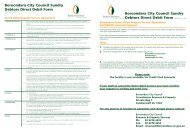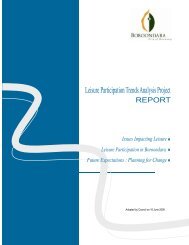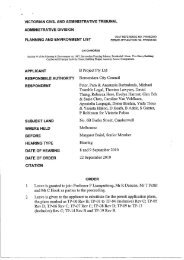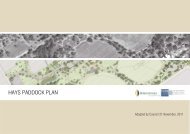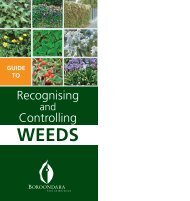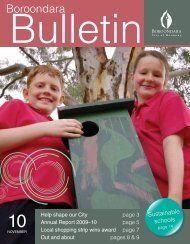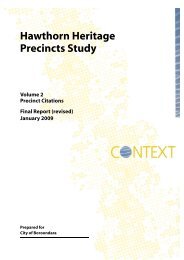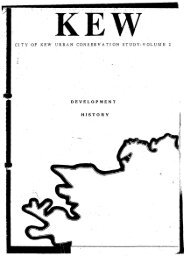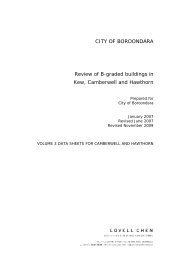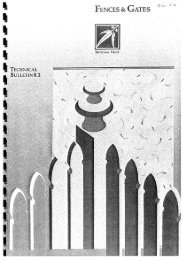Camberwell Conservation Study 1991 Vol 3 - City of Boroondara
Camberwell Conservation Study 1991 Vol 3 - City of Boroondara
Camberwell Conservation Study 1991 Vol 3 - City of Boroondara
You also want an ePaper? Increase the reach of your titles
YUMPU automatically turns print PDFs into web optimized ePapers that Google loves.
Palm Grove<br />
The street is a continuation <strong>of</strong> the Spanish/Mediterranean<br />
villa and Old English style, all being large houses<br />
<strong>of</strong>brick and stucco construction.<br />
Salisbury Street<br />
Starting with Number 1, on the east side, the street has<br />
a group <strong>of</strong> individually notable houses ending at 7. All<br />
are notable but not <strong>of</strong> a similar construction date. The<br />
street has a patch <strong>of</strong> individually notable Old English<br />
houses, Numbers 22, 24, 26 being a notable group.<br />
Number 21 is a similar scale, opposite.<br />
BowleyAvenue<br />
The street has a concrete roadway at Salisbury Street,<br />
Old English style mixedwith Georgian revival houses <strong>of</strong><br />
the 1930s and 40$, plus new unrelated development,<br />
particularly on the south side.<br />
Ruhbank Avenue<br />
The street has a concrete roadway and the Old English<br />
style is dominant among the houses. There is a median<br />
at the end <strong>of</strong> the cul- de-sac and later Georgian revival<br />
houses at the end, unrelated to the Old English but<br />
sharing some <strong>of</strong> the stucco character <strong>of</strong> the earlier<br />
houses in the rest <strong>of</strong> the estate.<br />
Reid Street<br />
Mixed development, with some individually notable Old<br />
English style houses on the west side. The streetdoes not<br />
form part <strong>of</strong> the Precinct.<br />
Belmont Avenue<br />
The street has a concrete roadwaybut the street does not<br />
form part <strong>of</strong> the Precinct.<br />
Parkside Avenue<br />
The street has a concrete roadway, east side only, facing<br />
the park on the west. It has a mixture <strong>of</strong>late 1920$, early<br />
1930$ houses, including 9, with unpainted stucco and<br />
mature original garden.<br />
Myambert Avenue<br />
Presumably carved from the grounds <strong>of</strong>the Reid family's<br />
former house, Myambert, at number one Myambert<br />
Avenue, this street contains houses which concur with<br />
the rest <strong>of</strong> the estate inage and stylewith the Old English<br />
style dominating. A notable element is the old gum at<br />
the end <strong>of</strong> the street, retained on a median formed by the<br />
turning radius, which expresses some <strong>of</strong> the aims <strong>of</strong> the<br />
Reids for Belmont Park, in keeping the native vegetation.<br />
Bamsbury Road<br />
Straddling the railway line in its connection to the precinct,<br />
the street contains individually significant houses<br />
(number 9) as well as contributory sites (1920$-30$).<br />
Canonbury's garden has a further unifyingeffect with its<br />
mature growth and visibility.<br />
Significance<br />
A good example <strong>of</strong> the impact <strong>of</strong> local site control<br />
regulations with minimum 50 feet frontages. It is an<br />
example <strong>of</strong> the manner in which the large 1880sproperties<br />
were <strong>of</strong>ten not divided until the inter-war years <strong>of</strong><br />
the twentieth century. This precinct demonstrates the<br />
<strong>Camberwell</strong> <strong>Conservation</strong> <strong>Study</strong> <strong>1991</strong> - Significant Areas<br />
process <strong>of</strong> subdivisions and building common in much<br />
<strong>of</strong> <strong>Camberwell</strong>.<br />
Historically the process <strong>of</strong> subdivision, sale and building<br />
over two decades is evident along with the influence <strong>of</strong><br />
building controls to ensure distinctive quality. Theresult<br />
is a perceivable middle- class enclave, housing over the<br />
years a number <strong>of</strong> important Victorians.<br />
Architecturally the housing includes individually important<br />
examples and is significant as a notable group <strong>of</strong><br />
mainly 1930$ designs <strong>of</strong> a wide range <strong>of</strong> styles set in a<br />
contemporary con text <strong>of</strong> concrete roadways and landscape.<br />
Historically significant as an example <strong>of</strong> 1930$ estate<br />
development, with a comparatively high degree <strong>of</strong> integrity.<br />
Important as a high-quality estate with a full range <strong>of</strong> the<br />
characteristic housing styles <strong>of</strong> the 1930$ and with the<br />
period character extended into street form (especially<br />
the use <strong>of</strong> concrete) and plantings. These have survived<br />
here where they have been lost in other estates.<br />
A good example <strong>of</strong> the impact <strong>of</strong> local site control<br />
regulations with minimum 50 feet frontages. Itdemonstrates<br />
some <strong>of</strong> the characteristic aspects <strong>of</strong> subdivision<br />
and building in <strong>Camberwell</strong>. The delay between subdivision<br />
in the 1880$ and building in the 1920$; the impact<br />
<strong>of</strong> public transport on subdivision and sale; the emphasis<br />
on rural qualities and views in descriptions <strong>of</strong> the<br />
estate and the superior quality <strong>of</strong> the buildings themselves.<br />
Especially important are the nostalgic Old<br />
English styles so closelyassociated with the character<strong>of</strong><br />
<strong>Camberwell</strong>.



